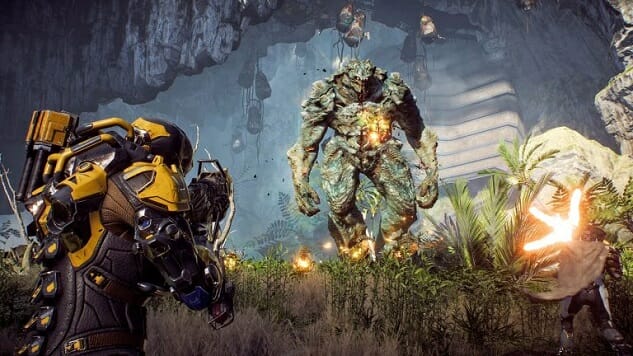The Disappointing Anthem Tries to Do Too Much

About six hours into my time with Anthem, I was given a quest to explore the four tombs of the Legionnaires of Dawn, mythical ancient Javelin pilots whose bravery inspired those who survived them to name their great city “Fort Tarsis” after Legionnaire Helena Tarsis. It’s the kind of good backstory you expect from Bioware, tinged with a mysterious past and interwoven with technology and supernatural forces.
The tombs themselves are not hard to find, exactly—they’ll show up on your world map just like any other objective—but each requires completing a “trial of the Legionnaire” to enter, which generally has to do with completing a number of actions in the Freeplay open-world: open 15 treasure chests, eliminate 50 enemies with an ultimate ability, strike 15 weak points, et cetera. There are fifteen of these checkpoint goals in total, with three or four in each Tomb.
This quest is a pain. It’s an infamous pain—the number of complaints about it if you do a quick search for “Anthem Tombs” should give you a quick idea. It’s also indicative of exactly what makes Anthem such a confused mess of a game, a clumsy middle-point between traditional Bioware storytelling and design-for-infinite-playtime AAA tenets.
The land surrounding Fort Tarsis, the space that you as a player have come to know in your first few hours as “where missions take place”, is also home to Anthem’s Freeplay mode, where you can fly around in your rocket-suit Javelin and handle whatever random encounters or treasure hunts you wish, as three other random players inhabit the vast area with you.
I say “inhabit” here because you, and the three other players, are really the only inhabitants of the land outside of Fort Tarsis. Unlike the much-derided Fallout 76 before it, Anthem does offer the slightest hints of life in its colorful, jungled wastelands, but they are primarily just that: hints.
A squadron of Sentinels (essentially the security forces of Fort Tarsis) might need reviving after they are pinned down by outlaws, or perhaps the rare Arcanist has fled the libraries of the Fort in search of greater treasure but requires help dealing with a monstrous Titan. There are hints of life out here, yes. There are hints of life in Anthem.

The game is a visual triumph, with the world surrounding Tarsis colored in vibrant greens and the grey-white of towering cliffs and ancient architecture. A special note should be made of the game’s score, primarily composed by Sarah Schachner, for being one of the game’s more masterful design choices, a slick blend of electronic and traditional orchestra sounds, the perfect companion to the “castles & rocket-suits” aesthetic of Anthem.
Javelins are similarly notable, with a healthy variety of visual designs between the bulky Colossus, the all-arounder Ranger, the elemental Storm, and the agile Interceptor. As was heavily touted in pre-release materials, Javelins can be heavily customized, both in loadout and appearance, and it’s hard not to feel some joy in playing dress-up with your robot suit. Even without spending some money in the Anthem store, plenty of options are available at start, with even more as you level up.
Anthem is fundamentally two games: There is a game that you play with your friends, where you fly around in your Javelin and shoot enemies and/or shoot the shit, the game that seemingly every part of Anthem wants to route you toward, as evidenced by the Legionnaires’ Tombs questline; and then there is the other Anthem, the Anthem that exists in the shadow of the shooter-looter extravaganza Anthem. This Anthem has characters, has story, has some genuinely well-written twists and turns.
This second Anthem is the Anthem I wanted to play since I first heard of the game. It’s likely the Anthem that most Bioware fans were looking forward to. And after playing a couple dozen hours of this game called Anthem, I have come to the small, slightly depressing conclusion that this game is not that game.
-

-

-

-

-

-

-

-

-

-

-

-

-

-

-

-

-

-

-

-

-

-

-

-

-

-

-

-

-

-

-

-

-

-

-

-

-

-

-

-








































